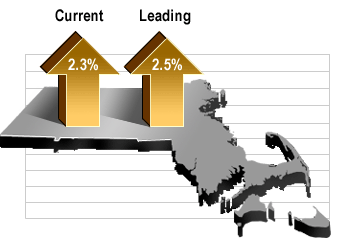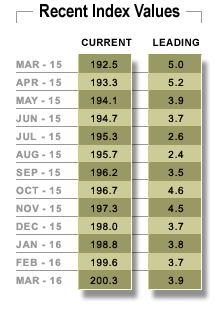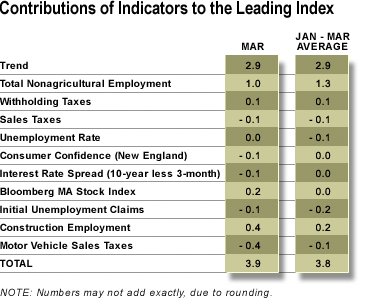Economic growth in Mass. improves in Q1, UMass journal reports
Unemployment rate now below pre-recession low; Moderate growth expected in Q2 and Q3
March 2016
 Massachusetts real gross domestic product grew at an annual rate of 2.3 percent in the first quarter of 2016 according to the MassBenchmarks Current Economic Index, released today by MassBenchmarks, the journal of the Massachusetts economy published by the UMass Donahue Institute in collaboration with the Federal Reserve Bank of Boston. In contrast, according to the U.S. Department of Commerce, national real gross domestic product grew at an annual rate of 0.5 percent during the same period.
Massachusetts real gross domestic product grew at an annual rate of 2.3 percent in the first quarter of 2016 according to the MassBenchmarks Current Economic Index, released today by MassBenchmarks, the journal of the Massachusetts economy published by the UMass Donahue Institute in collaboration with the Federal Reserve Bank of Boston. In contrast, according to the U.S. Department of Commerce, national real gross domestic product grew at an annual rate of 0.5 percent during the same period.
Recently revised data now reveal that in 2015, the state’s economy expanded at an annual rate of 1.4 percent in the fourth quarter (1.4% for the US), 2.0 percent in the third quarter (2.0%), 4.9 percent in the second quarter (3.9%), and 2.0 percent in the first quarter (0.6%).
 The pace of economic growth in Massachusetts picked up in the first three months of 2016 after slowing in the second half of 2015. Although underlying indicators were mixed, both employment and earnings recorded strong growth and the unemployment rate fell. Payroll employment grew at a 2.0 percent annual rate in the first quarter, up from 0.7 percent in the prior quarter. Wage and salary income, as estimated from state withholding tax revenue, expanded 5.6 percent in the first quarter, after falling 7.0 percent in the final three months of last year.
The pace of economic growth in Massachusetts picked up in the first three months of 2016 after slowing in the second half of 2015. Although underlying indicators were mixed, both employment and earnings recorded strong growth and the unemployment rate fell. Payroll employment grew at a 2.0 percent annual rate in the first quarter, up from 0.7 percent in the prior quarter. Wage and salary income, as estimated from state withholding tax revenue, expanded 5.6 percent in the first quarter, after falling 7.0 percent in the final three months of last year.
The state’s headline unemployment rate – the so-called U-3 measure – stood at 4.4 percent in March, down from 4.9 percent in December, and down from 5.1 percent in March of 2015. The U.S. unemployment rate in March was 5.0 percent, the same as in December, and down from 5.5 percent in March of last year. The unemployment rate in Massachusetts is now lower than its pre-recession low of 4.6 percent in 2007.
But this overall strong performance continues to mask troubling imbalances in the labor market. The broader U-6 measure of unemployment, which includes those who are working part-time but want full-time work, as well as those who are marginally attached to the labor force, is still significantly above pre-recession levels. It inched down to 9.3 percent in March from 9.5 percent in December and 9.8 percent in March 2015. The U.S. rate in March was 9.8 percent, down from 9.9 percent in December and 10.9 percent in March 2015. Prior to the recession in 2007, the U-6 reached lows of 7.1 percent in Massachusetts and 8.0 percent in the U.S.
 "Spending on items subject to the state regular sales tax declined by 6.3 percent in the first quarter, in stark contrast to the very strong growth of 9.5 percent experienced in the fourth quarter of 2015. Year over year, spending is up 3.5 percent," noted Alan Clayton-Matthews, MassBenchmarks Senior Contributing Editor and Associate Professor of Economics and Public Policy at Northeastern University, who compiles and analyzes the Current and Leading Indexes. "Most of the drop this quarter was due to spending on automobiles, which slowed after expanding strongly at the end of 2015, and also to weak spending on other taxable sales items in February."
"Spending on items subject to the state regular sales tax declined by 6.3 percent in the first quarter, in stark contrast to the very strong growth of 9.5 percent experienced in the fourth quarter of 2015. Year over year, spending is up 3.5 percent," noted Alan Clayton-Matthews, MassBenchmarks Senior Contributing Editor and Associate Professor of Economics and Public Policy at Northeastern University, who compiles and analyzes the Current and Leading Indexes. "Most of the drop this quarter was due to spending on automobiles, which slowed after expanding strongly at the end of 2015, and also to weak spending on other taxable sales items in February."
The Massachusetts Department of Revenue recorded weaker bonus payouts in February, tied to stock market performance and corporate profits. Market fear tends to dampen business confidence and investment, and a prolonged market downturn may restrain consumer spending as well.
The MassBenchmarks Leading Economic Index suggests that the state economy will continue to grow at a moderate pace over the next six months, at a 3.1 percent rate in the second quarter, and a 2.5 percent rate in the third quarter of this year. The factors weighing on the state and national economic outlook have changed little from last quarter.
One factor is the tightening labor market. As there are fewer unemployed workers and as more baby boomers retire, it is becoming more difficult for employers to find the workers they need. This is reflected in historically low levels of initial unemployment claims, a sign that employers are reacting to the tightening labor market by holding on to the workers they have. Another factor is slower worldwide economic growth as China's rapid pace of economic growth has decelerated, Japan's economy is stalled, and Europe remains sluggish. A third is turmoil in financial markets. Although volatility in stock markets in reaction to falling commodity prices has calmed, there are remaining downside risk factors related to the fallout of weak global demand on corporate profits.
 The 10 indicators that comprise the leading index usually do not all move in tandem. Typically, some may indicate an expectation of faster than average growth, while at the same time others may indicate an expectation of slower than average growth. The accompanying table accounts for the contributions of each towards faster or slower growth than the trend of 2.9 percent. The index value is their sum.
The 10 indicators that comprise the leading index usually do not all move in tandem. Typically, some may indicate an expectation of faster than average growth, while at the same time others may indicate an expectation of slower than average growth. The accompanying table accounts for the contributions of each towards faster or slower growth than the trend of 2.9 percent. The index value is their sum.
In March, four indicators contributed to a forecast of above-trend growth: total nonagricultural employment, withholding taxes, the Bloomberg stock index for Massachusetts, and construction employment. One indicator, the unemployment rate, contributed to average-trend growth. Five indicators contributed to below-trend growth: sales taxes, consumer confidence, the interest rate spread between 10‑year and 3‑month U.S. Treasury securities, initial unemployment claims, and motor vehicle sales taxes.
In the three-month period January through March, three indicators contributed to a forecast of above-trend growth: total nonagricultural employment, withholding taxes, and construction employment. Three indicators contributed to average-trend growth: consumer confidence, the interest rate spread between 10‑year and 3‑month U.S. Treasury securities, and the Bloomberg stock index for Massachusetts. Four indicators contributed to below-trend growth: sales taxes, the unemployment rate, initial unemployment claims, and motor vehicle sales taxes.
The current and historical quarterly estimates for state domestic product growth include adjustments for changes in productivity growth. These adjustments are estimates of the quarterly deviations from the 1978-2014 trend in the growth of the ratio of output to employment and output to wage and salary income. In the first quarter of 2016, these adjustments subtracted 2.3 percentage points from growth. In the fourth quarter of 2015, these adjustments subtracted 2.0 percentage points from growth. In the third quarter of 2015, these adjustments subtracted 1.5 percentage points from growth. In the second quarter of 2015, these adjustments subtracted 0.2 percentage points from growth. For the forecast of state domestic product growth in the second and third quarters of this year, productivity growth is assumed to return to the average of the last five years.
Several recent months of the indices are revised each release. These revisions are a result of the statistical method used to create the index, as well as revisions in the underlying indicators.
--------
All of the indicators except interest rates refer to Massachusetts. The current index is composed of four indicators: nonagricultural employment, withholding taxes, sales taxes, and the unemployment rate. The leading index includes these four current indicators plus the other six (leading) indicators in the contributions table. All of the indicators are as of March, except for interest rates and the Bloomberg stock index for Massachusetts, which are through April 22. The MassInsight Consumer Confidence Index is released every third month. Intervening months are interpolated, and changes in the Conference Board's Consumer Confidence Index for the U.S. are used to extrapolate to the current month of the index, as needed. Series measured in current dollars or values, i.e., withholding taxes, sales taxes, the Bloomberg stock index, and motor vehicle sales taxes, are deflated by the U.S. consumer price index for all urban consumers, excluding food and energy.
For a description of the methodology used to construct these indices, see: Alan Clayton-Matthews and James H. Stock, "An application of the Stock/Watson index methodology to the Massachusetts economy," Journal of Economic and Social Measurement, vol. 25 (1998/1999), pp. 183-233.
Dr. Alan Clayton-Matthews
MassBenchmarks
Northeastern University, School of Public Policy and Urban Affairs
April 28, 2016

